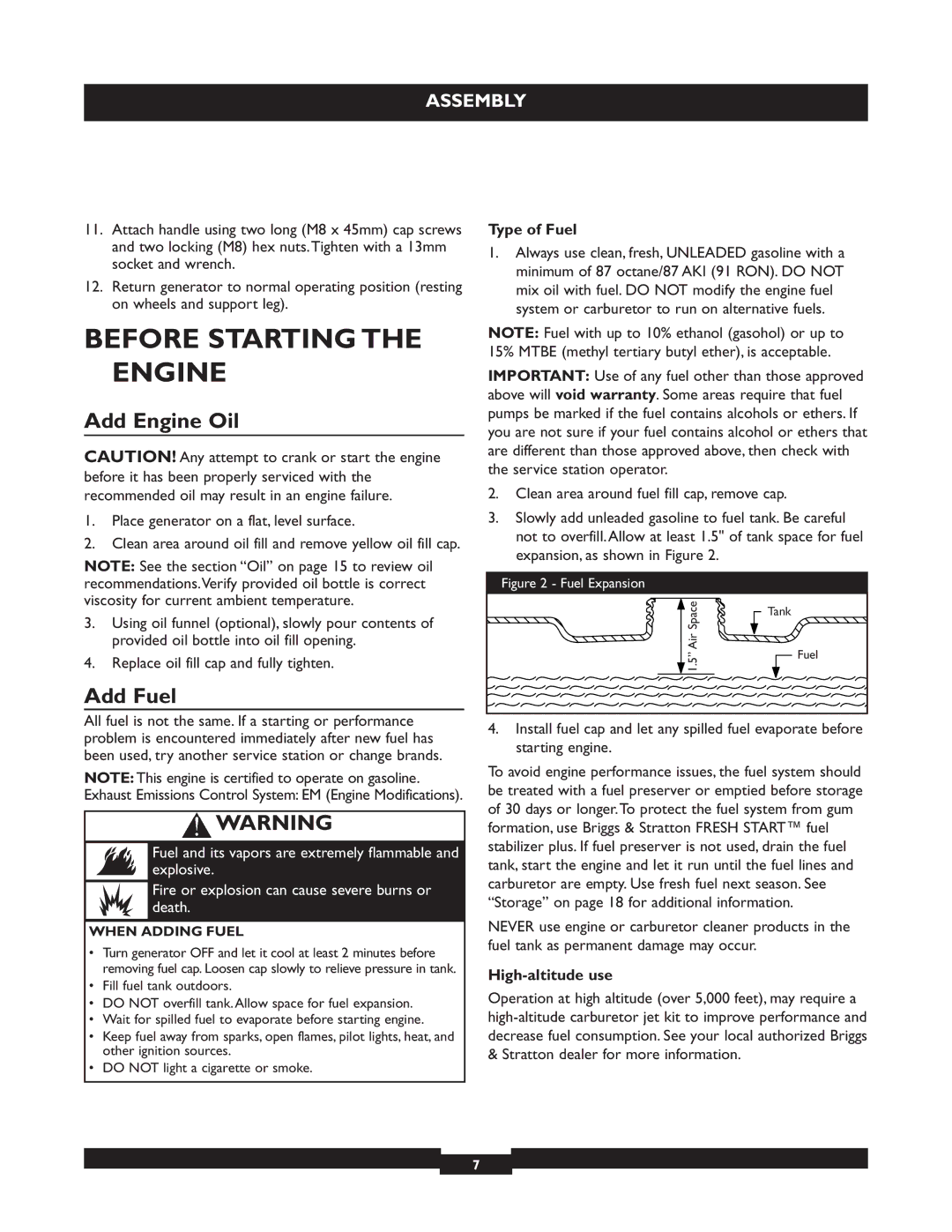
ASSEMBLY
11.Attach handle using two long (M8 x 45mm) cap screws and two locking (M8) hex nuts.Tighten with a 13mm socket and wrench.
12.Return generator to normal operating position (resting on wheels and support leg).
BEFORE STARTING THE ENGINE
Add Engine Oil
CAUTION! Any attempt to crank or start the engine before it has been properly serviced with the recommended oil may result in an engine failure.
1.Place generator on a flat, level surface.
2.Clean area around oil fill and remove yellow oil fill cap.
NOTE: See the section “Oil” on page 15 to review oil recommendations.Verify provided oil bottle is correct viscosity for current ambient temperature.
3.Using oil funnel (optional), slowly pour contents of provided oil bottle into oil fill opening.
4.Replace oil fill cap and fully tighten.
Add Fuel
All fuel is not the same. If a starting or performance problem is encountered immediately after new fuel has been used, try another service station or change brands.
NOTE: This engine is certified to operate on gasoline.
Exhaust Emissions Control System: EM (Engine Modifications).
![]() WARNING
WARNING
Fuel and its vapors are extremely flammable and explosive.
Fire or explosion can cause severe burns or death.
WHEN ADDING FUEL
•Turn generator OFF and let it cool at least 2 minutes before removing fuel cap. Loosen cap slowly to relieve pressure in tank.
•Fill fuel tank outdoors.
•DO NOT overfill tank. Allow space for fuel expansion.
•Wait for spilled fuel to evaporate before starting engine.
•Keep fuel away from sparks, open flames, pilot lights, heat, and other ignition sources.
•DO NOT light a cigarette or smoke.
Type of Fuel
1.Always use clean, fresh, UNLEADED gasoline with a minimum of 87 octane/87 AKI (91 RON). DO NOT mix oil with fuel. DO NOT modify the engine fuel system or carburetor to run on alternative fuels.
NOTE: Fuel with up to 10% ethanol (gasohol) or up to 15% MTBE (methyl tertiary butyl ether), is acceptable.
IMPORTANT: Use of any fuel other than those approved above will void warranty. Some areas require that fuel pumps be marked if the fuel contains alcohols or ethers. If you are not sure if your fuel contains alcohol or ethers that are different than those approved above, then check with the service station operator.
2.Clean area around fuel fill cap, remove cap.
3.Slowly add unleaded gasoline to fuel tank. Be careful not to overfill. Allow at least 1.5" of tank space for fuel expansion, as shown in Figure 2.
Figure 2 - Fuel Expansion
AirSpace | Tank | |
Fuel | ||
1.5” | ||
|
4.Install fuel cap and let any spilled fuel evaporate before starting engine.
To avoid engine performance issues, the fuel system should be treated with a fuel preserver or emptied before storage of 30 days or longer.To protect the fuel system from gum formation, use Briggs & Stratton FRESH START™ fuel stabilizer plus. If fuel preserver is not used, drain the fuel tank, start the engine and let it run until the fuel lines and carburetor are empty. Use fresh fuel next season. See “Storage” on page 18 for additional information.
NEVER use engine or carburetor cleaner products in the fuel tank as permanent damage may occur.
High-altitude use
Operation at high altitude (over 5,000 feet), may require a
7
